
After the game between Royal Challengers Bangalore and Mumbai Indians on March 28, the RCB captain Virat Kohli was seen quite visibly distraught as he argued with the umpire. The reason — the final ball bowled by MI bowler Lasith Malinga was adjudged legal, even though he had clearly overstepped, as shown in the replays.
RCB needed six runs of the final ball and had it been a no-ball, not only would they have got another ball to win, the number of runs required could also have come down to 3 from 1 ball since the batsmen had taken two runs off that ball.
After the match, Kohli was livid at the on-field umpire S Ravi, who was behind this controversial decision, after it was shown on the stadium’s giant LED screen.
However, umpiring howlers in IPL are nothing new. In fact, the 2018 edition saw more than 25 umpiring howlers — almost one in every two matches. In a crucial match between the Kings XI Punjab and Kolkata Knight Riders last year, the umpire handed KKR a free hit, even though bowler Andrew Tye hadn’t clearly overstepped. In another match, between Sunrisers Hyderabad and CSK, Shardul Thakur bowled a clear ball above waist height to Kane Williamson, which was not considered a no-ball by the umpires.
Both these mistakes were caused by an Indian umpire, Vineet Kulkarni, who had to resign from ICC’s Elite Umpiring Panel owing to the many controversial decisions he had taken in the India–South Africa series in 2016.
It was last year, that BCCI decided that there will be more Indian umpires in the IPL as they wanted to promote more local talent, and cut down on the umpiring recruits from other countries. Currently there are 11 Indian umpires in the IPL, and six are from foreign countries. In fact, out of this 11 only three- Shamsuddin, Anil Menon and S Ravi- are licensed by ICC to officiate in international matches.
In fact, Indian umpires have also been accused of poor decision making at the domestic level. In the Ranji Trophy semi-final between Karnataka and Saurashtra, umpire Saiyed Khali failed to spot a clear outside edge by Cheteshwar Pujar off Vinay Kumar’s delivery. Pujara went on to score a century and guided Saurashtra to the Ranji finals.
Since the Committee of Administrators have taken over cricketing decisions by the BCCI, as advised by the Supreme Court, the Central Umpiring Committee was dissolved early last year, and now the umpiring recruitments and training are looked after by the CoA director. This umpiring committee, not only recruited umpires but trained them for the big stage.
Again, after the arrival of the CoA the IPL governing council, which looked after everything basic related to the tournament- from pitch conditions to umpires- was also dissolved. Now, the umpires are only held accountable to the CoA, who conduct meetings once every few months, and thus they get away for the immediate future after making such howlers.
The new umpire rating system, which has been developed by the BCCI has also come under the scanner. Under the new system, the match referees and umpires appointed for a particular match rate each other out of 100, and thus the issue of fairness also comes under scrutiny.
“The marking is too harsh as well. In every match, an umpire starts with 100 marks (60 for decision making, 40 for other things like communication, body language, team work etc.) So, from this 60, the first error costs me five marks. The second error costs me 10 more marks, so I come down to 45. If I have a third error in a game, automatically it comes to 30. Suppose I’m doing a Ranji game and I err in the first ball, imagine the external pressure on me for the next four days,” a senior umpire, who did not wish to be named, told a leading cricket website.
The recruitment of umpires by the BCCI has also come under intense question. There is only one National Academy of Umpires in Nagpur, and several aspiring umpires have alleged that people with recommendation by the local cricket board supremos make the cut, irrespective of their talent or skill. In fact, the chairman of this academy has also been accused of setting the question papers for the BCCI umpiring tests, so that candidates from this institute only can qualify for the official BCCI umpiring licence.
Indian umpiring has has seen markedgly poor decisions. While the country continues to produce one good player after another, there have been only two umpires in the ICC Elite Panel till date. One was S Venkatraghavan and now S Ravi, the man behind the Malinga no-ball controversy, is a member.
So, if an elite level umpire like S Ravi can make such a basic mistake at such a crucial juncture of a match, it is not hard to deduce the level of umpiring at the basic grassroot level. Thus, while the international cricket community considers India as a gold mine for cricketing talent, on the umpiring front, it is definitely far far behind.
Delhi Fire Service has initiated comprehensive fire safety inspection drive in restaurants, hotels and clubs…
Out of 40 air quality monitoring stations across the city, 14 recorded severe air quality…
Govt, however, acknowledged that air pollution is one of the triggering factors for respiratory ailments…
Rising air pollution levels in the capital, the Delhi government on Thursday undertook a comprehensive…
Parents say online classes during severe air pollution ignore the digital realities of economically weaker…
Rival leagues trigger players’ suspensions and a legal battle in Indian golf, for now